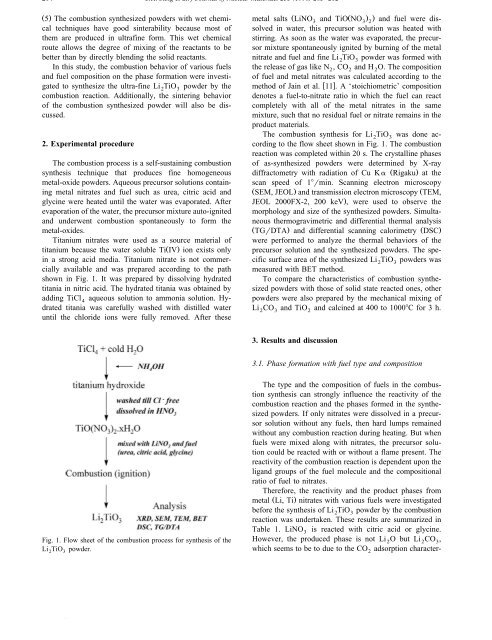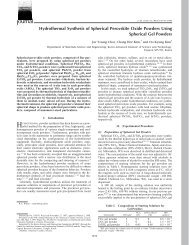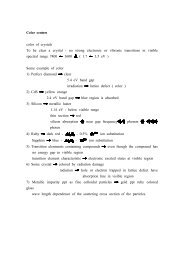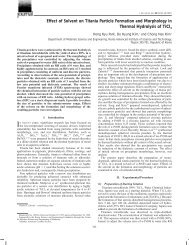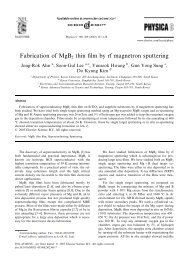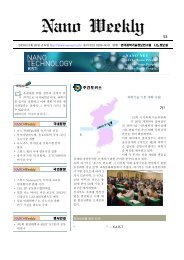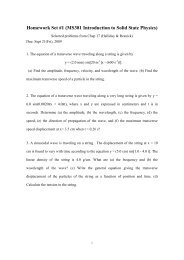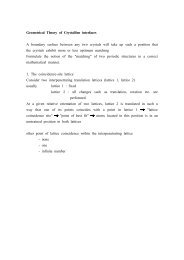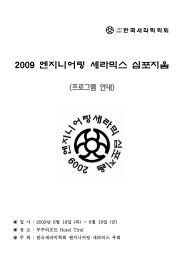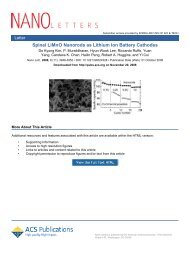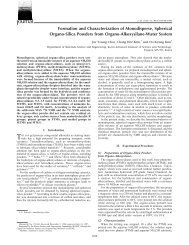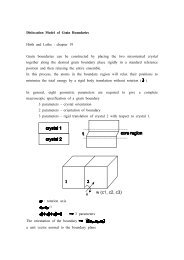Synthesis of Li TiO ceramic breeder powders by the combustion ...
Synthesis of Li TiO ceramic breeder powders by the combustion ...
Synthesis of Li TiO ceramic breeder powders by the combustion ...
Create successful ePaper yourself
Turn your PDF publications into a flip-book with our unique Google optimized e-Paper software.
204<br />
Ž. 5 The <strong>combustion</strong> syn<strong>the</strong>sized <strong>powders</strong> with wet chemical<br />
techniques have good sinterability because most <strong>of</strong><br />
<strong>the</strong>m are produced in ultrafine form. This wet chemical<br />
route allows <strong>the</strong> degree <strong>of</strong> mixing <strong>of</strong> <strong>the</strong> reactants to be<br />
better than <strong>by</strong> directly blending <strong>the</strong> solid reactants.<br />
In this study, <strong>the</strong> <strong>combustion</strong> behavior <strong>of</strong> various fuels<br />
and fuel composition on <strong>the</strong> phase formation were investigated<br />
to syn<strong>the</strong>size <strong>the</strong> ultra-fine <strong>Li</strong>2<strong>TiO</strong>3 powder <strong>by</strong> <strong>the</strong><br />
<strong>combustion</strong> reaction. Additionally, <strong>the</strong> sintering behavior<br />
<strong>of</strong> <strong>the</strong> <strong>combustion</strong> syn<strong>the</strong>sized powder will also be discussed.<br />
2. Experimental procedure<br />
The <strong>combustion</strong> process is a self-sustaining <strong>combustion</strong><br />
syn<strong>the</strong>sis technique that produces fine homogeneous<br />
metal-oxide <strong>powders</strong>. Aqueous precursor solutions containing<br />
metal nitrates and fuel such as urea, citric acid and<br />
glycine were heated until <strong>the</strong> water was evaporated. After<br />
evaporation <strong>of</strong> <strong>the</strong> water, <strong>the</strong> precursor mixture auto-ignited<br />
and underwent <strong>combustion</strong> spontaneously to form <strong>the</strong><br />
metal-oxides.<br />
Titanium nitrates were used as a source material <strong>of</strong><br />
titanium because <strong>the</strong> water soluble TiŽ IV. ion exists only<br />
in a strong acid media. Titanium nitrate is not commercially<br />
available and was prepared according to <strong>the</strong> path<br />
shown in Fig. 1. It was prepared <strong>by</strong> dissolving hydrated<br />
titania in nitric acid. The hydrated titania was obtained <strong>by</strong><br />
adding TiCl aqueous solution to ammonia solution. Hy-<br />
4<br />
drated titania was carefully washed with distilled water<br />
until <strong>the</strong> chloride ions were fully removed. After <strong>the</strong>se<br />
Fig. 1. Flow sheet <strong>of</strong> <strong>the</strong> <strong>combustion</strong> process for syn<strong>the</strong>sis <strong>of</strong> <strong>the</strong><br />
<strong>Li</strong> <strong>TiO</strong> powder.<br />
2 3<br />
C.H. Jung et al.rJournal <strong>of</strong> Nuclear Materials 253 1998 203–212<br />
metal salts Ž<strong>Li</strong>NO and <strong>TiO</strong>Ž NO . . and fuel were dis-<br />
3 3 2<br />
solved in water, this precursor solution was heated with<br />
stirring. As soon as <strong>the</strong> water was evaporated, <strong>the</strong> precursor<br />
mixture spontaneously ignited <strong>by</strong> burning <strong>of</strong> <strong>the</strong> metal<br />
nitrate and fuel and fine <strong>Li</strong> <strong>TiO</strong> powder was formed with<br />
2 3<br />
<strong>the</strong> release <strong>of</strong> gas like N , CO and H O. The composition<br />
2 2 2<br />
<strong>of</strong> fuel and metal nitrates was calculated according to <strong>the</strong><br />
method <strong>of</strong> Jain et al. w11 x.<br />
A ‘stoichiometric’ composition<br />
denotes a fuel-to-nitrate ratio in which <strong>the</strong> fuel can react<br />
completely with all <strong>of</strong> <strong>the</strong> metal nitrates in <strong>the</strong> same<br />
mixture, such that no residual fuel or nitrate remains in <strong>the</strong><br />
product materials.<br />
The <strong>combustion</strong> syn<strong>the</strong>sis for <strong>Li</strong>2<strong>TiO</strong>3 was done according<br />
to <strong>the</strong> flow sheet shown in Fig. 1. The <strong>combustion</strong><br />
reaction was completed within 20 s. The crystalline phases<br />
<strong>of</strong> as-syn<strong>the</strong>sized <strong>powders</strong> were determined <strong>by</strong> X-ray<br />
diffractometry with radiation <strong>of</strong> Cu Ka Ž Rigaku. at <strong>the</strong><br />
scan speed <strong>of</strong> 18rmin. Scanning electron microscopy<br />
Ž SEM, JEOL. and transmission electron microscopy ŽTEM,<br />
JEOL 2000FX-2, 200 keV . , were used to observe <strong>the</strong><br />
morphology and size <strong>of</strong> <strong>the</strong> syn<strong>the</strong>sized <strong>powders</strong>. Simultaneous<br />
<strong>the</strong>rmogravimetric and differential <strong>the</strong>rmal analysis<br />
Ž TGrDTA. and differential scanning calorimetry Ž DSC.<br />
were performed to analyze <strong>the</strong> <strong>the</strong>rmal behaviors <strong>of</strong> <strong>the</strong><br />
precursor solution and <strong>the</strong> syn<strong>the</strong>sized <strong>powders</strong>. The specific<br />
surface area <strong>of</strong> <strong>the</strong> syn<strong>the</strong>sized <strong>Li</strong>2<strong>TiO</strong>3 <strong>powders</strong> was<br />
measured with BET method.<br />
To compare <strong>the</strong> characteristics <strong>of</strong> <strong>combustion</strong> syn<strong>the</strong>sized<br />
<strong>powders</strong> with those <strong>of</strong> solid state reacted ones, o<strong>the</strong>r<br />
<strong>powders</strong> were also prepared <strong>by</strong> <strong>the</strong> mechanical mixing <strong>of</strong><br />
<strong>Li</strong>2CO3 and <strong>TiO</strong>2 and calcined at 400 to 10008C for3h.<br />
3. Results and discussion<br />
3.1. Phase formation with fuel type and composition<br />
The type and <strong>the</strong> composition <strong>of</strong> fuels in <strong>the</strong> <strong>combustion</strong><br />
syn<strong>the</strong>sis can strongly influence <strong>the</strong> reactivity <strong>of</strong> <strong>the</strong><br />
<strong>combustion</strong> reaction and <strong>the</strong> phases formed in <strong>the</strong> syn<strong>the</strong>sized<br />
<strong>powders</strong>. If only nitrates were dissolved in a precursor<br />
solution without any fuels, <strong>the</strong>n hard lumps remained<br />
without any <strong>combustion</strong> reaction during heating. But when<br />
fuels were mixed along with nitrates, <strong>the</strong> precursor solution<br />
could be reacted with or without a flame present. The<br />
reactivity <strong>of</strong> <strong>the</strong> <strong>combustion</strong> reaction is dependent upon <strong>the</strong><br />
ligand groups <strong>of</strong> <strong>the</strong> fuel molecule and <strong>the</strong> compositional<br />
ratio <strong>of</strong> fuel to nitrates.<br />
Therefore, <strong>the</strong> reactivity and <strong>the</strong> product phases from<br />
metal Ž <strong>Li</strong>, Ti. nitrates with various fuels were investigated<br />
before <strong>the</strong> syn<strong>the</strong>sis <strong>of</strong> <strong>Li</strong> <strong>TiO</strong> powder <strong>by</strong> <strong>the</strong> <strong>combustion</strong><br />
2 3<br />
reaction was undertaken. These results are summarized in<br />
Table 1. <strong>Li</strong>NO is reacted with citric acid or glycine.<br />
3<br />
However, <strong>the</strong> produced phase is not <strong>Li</strong> O but <strong>Li</strong> CO ,<br />
2 2 3<br />
which seems to be to due to <strong>the</strong> CO adsorption character-<br />
2


